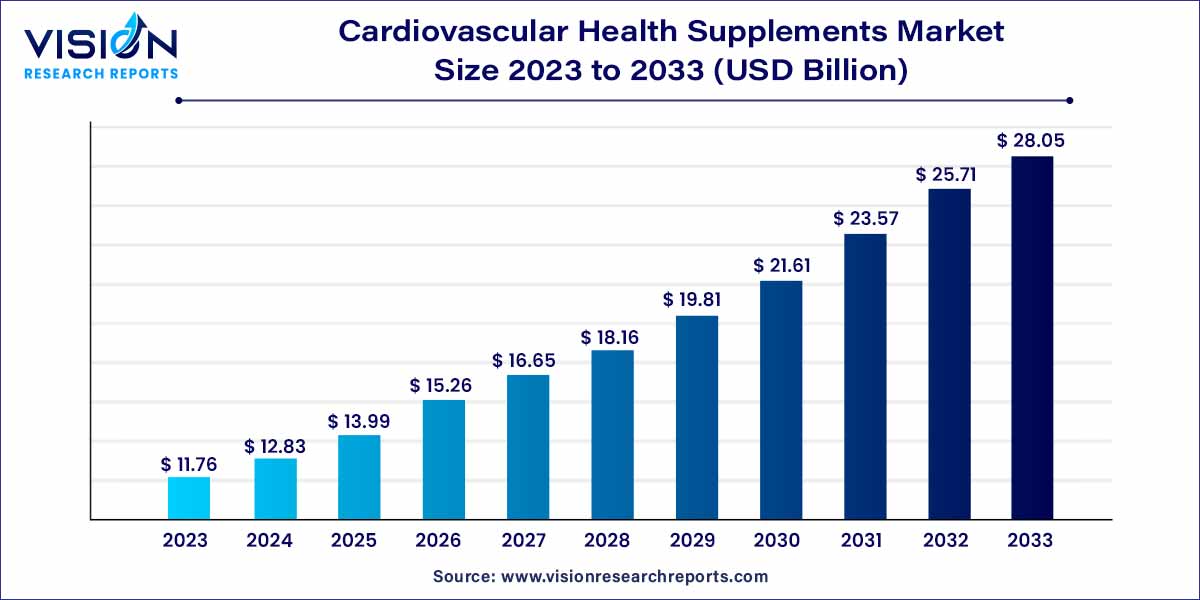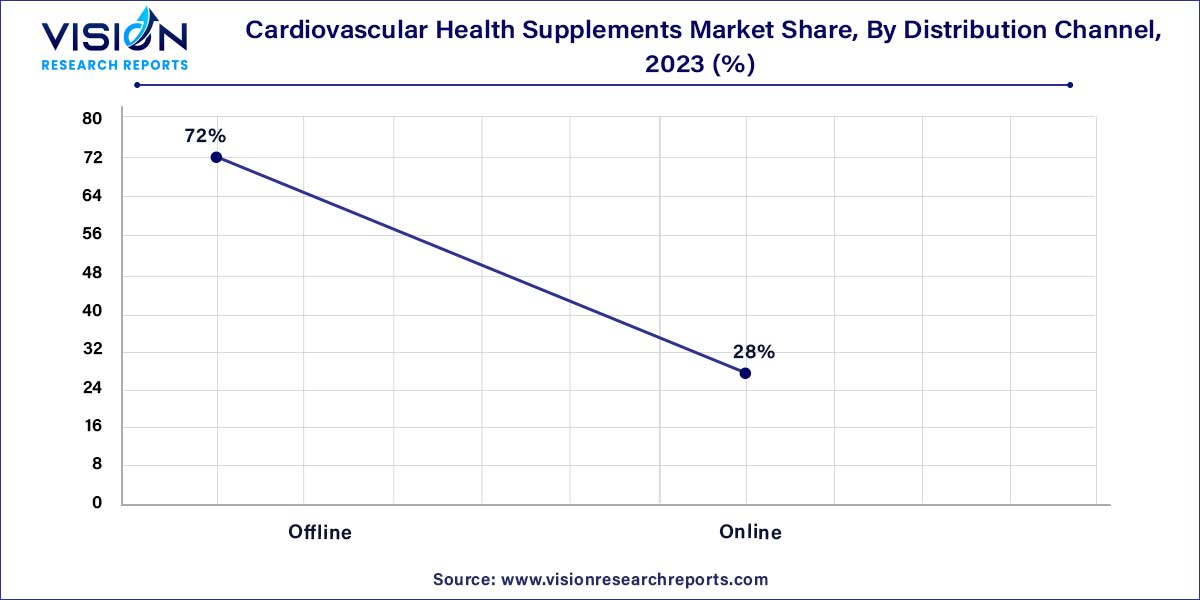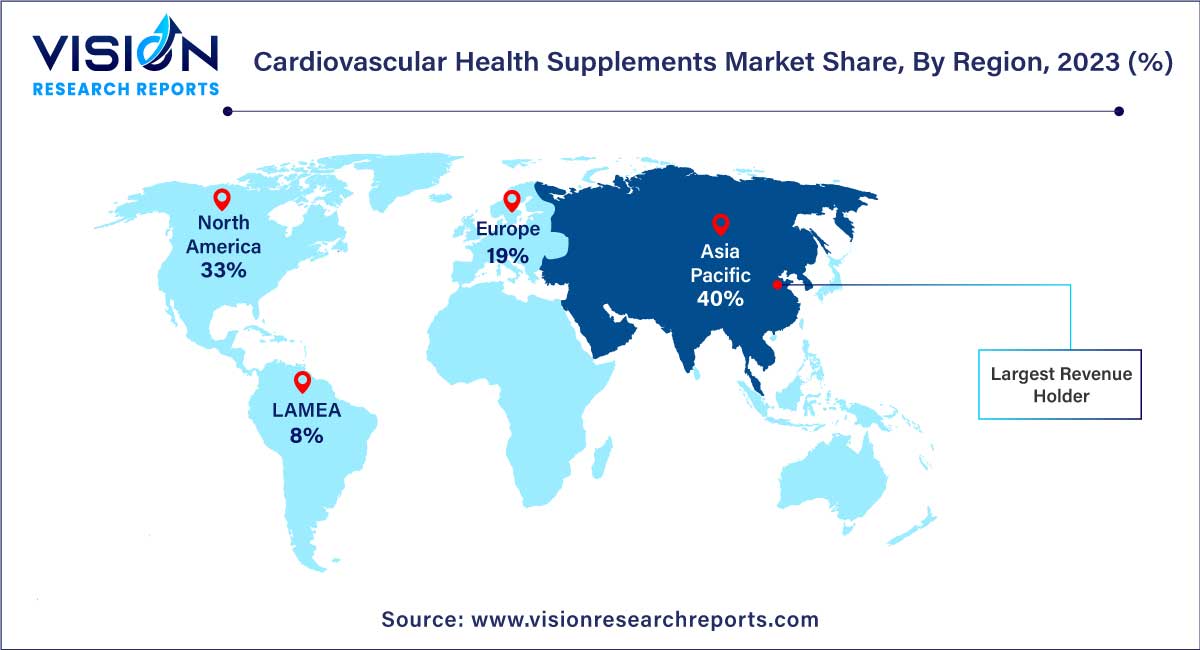The global cardiovascular health supplements market size was estimated at around USD 11.76 billion in 2023 and it is projected to hit around USD 28.05 billion by 2033, growing at a CAGR of 9.08% from 2024 to 2033.

The cardiovascular health supplements market is witnessing a significant surge in demand owing to the growing awareness about heart health and the increasing prevalence of cardiovascular diseases globally. Cardiovascular health supplements, comprising a wide range of vitamins, minerals, antioxidants, and herbal extracts, are designed to support heart function and reduce the risk of heart-related ailments.
The growth of the cardiovascular health supplements market can be attributed to several key factors. Firstly, the increasing awareness among individuals about the importance of cardiovascular health and the rising prevalence of heart-related diseases are driving the demand for these supplements. Secondly, the aging population, which is more susceptible to heart issues, is creating a significant consumer base for cardiovascular health products. Additionally, unhealthy lifestyles, sedentary habits, and stressful work environments have contributed to a surge in heart problems, prompting people to seek preventive measures through supplements. Furthermore, advancements in research and development, leading to innovative formulations and natural ingredients, are enhancing the efficacy of these supplements, attracting health-conscious consumers.
| Report Coverage | Details |
| Market Revenue by 2033 | USD 28.05 billion |
| Growth Rate from 2024 to 2033 | CAGR of 9.08% |
| Revenue Share of Asia Pacific in 2024 | 39% |
| CAGR of Europe from 2024 to 2033 | 8.91% |
| Base Year | 2023 |
| Forecast Period | 2024 to 2033 |
| Market Analysis (Terms Used) | Value (US$ Million/Billion) or (Volume/Units)Companies Covered |
The natural supplements segment held the largest market share of 71% in 2023 and it is expected to grow at the fastest CAGR of 9.49% over the forecast period. Natural supplements are derived from organic sources, such as herbs, plants, and marine extracts, known for their inherent health benefits. These supplements often contain vitamins, minerals, antioxidants, and omega-3 fatty acids sourced from natural sources. Due to their organic origins, natural supplements are perceived by consumers as healthier and safer alternatives. They are favored by individuals seeking products with minimal processing and additives, aligning with the growing trend towards natural and holistic health solutions.
The synthetic supplements segment is anticipated to grow at a significant CAGR of 8.18% during forecast period. Synthetic supplements are chemically formulated in laboratories to mimic the properties of natural nutrients. These supplements are designed to provide specific vitamins, minerals, and other essential compounds essential for cardiovascular health. Synthetic supplements offer precise control over nutrient concentrations, ensuring standardized dosages. They are often recommended in clinical settings where targeted nutrient supplementation is required.
The omega fatty acids segment registered the maximum market share of 28% in 2023. Omega fatty acids, particularly omega-3, are essential polyunsaturated fats known for their profound cardiovascular benefits. Derived mainly from fish oil and certain plant sources, omega-3 fatty acids have gained immense popularity due to their ability to reduce inflammation, lower blood pressure, and enhance overall heart health. Research studies supporting their efficacy have bolstered their reputation, making them a cornerstone ingredient in cardiovascular health supplements.
The herbs & botanicals segment is expected to grow at the fastest CAGR of 10.39% from 2024 to 2033. Herbs and botanicals have been integral to traditional medicine systems for centuries, owing to their medicinal properties. In the context of cardiovascular health supplements, various herbs and botanicals have gained prominence for their heart-friendly attributes. For instance, garlic is renowned for its potential to lower blood pressure and cholesterol levels, while hawthorn extract is valued for its ability to improve blood circulation and strengthen the heart muscle.
The softgels segment held the largest market share of 38% in 2023. Softgels, characterized by their gelatinous outer coating, encase liquid or oil-based supplements. This form offers several advantages, such as improved absorption rates and enhanced bioavailability of the enclosed nutrients. Softgels are particularly favored for cardiovascular health supplements containing omega-3 fatty acids, as the encapsulation method protects these sensitive oils from oxidation, ensuring the potency of the supplement. The smooth texture and easy swallowing make softgels a convenient option, especially for individuals with difficulty in ingesting larger pills or tablets.
The capsules segment is projected to exhibit the fastest CAGR of 9.97% over the forecast period. Capsules, on the other hand, consist of a two-piece outer shell, usually made from gelatin or plant-based materials, enclosing powdered or granulated supplement ingredients. This form is versatile and allows for the encapsulation of various nutrients, including vitamins, minerals, and herbal extracts, relevant to cardiovascular health. Capsules are preferred for their flexibility in formulation, enabling manufacturers to create customized blends tailored to specific heart health needs.
The offline segment contributed the largest market share of 72% in 2023. Offline distribution channels, which include brick-and-mortar stores, pharmacies, supermarkets, and specialty health stores, have long been the traditional way consumers purchase supplements. These physical retail outlets offer consumers the advantage of a tangible shopping experience, allowing them to see, touch, and evaluate products before making a purchase decision. Knowledgeable staff in these stores can also provide personalized recommendations and guidance, enhancing the consumer's shopping experience.

The online segment is expected to expand at the highest CAGR of 10.49% over forecast period. The online distribution channel has witnessed exponential growth with the advent of e-commerce platforms. Online retailing offers consumers unparalleled convenience and accessibility, allowing them to browse a vast array of cardiovascular health supplements from the comfort of their homes. The online marketplace provides detailed product information, customer reviews, and often offers a wider selection than physical stores. This channel appeals to the tech-savvy, time-conscious consumers seeking the ease of ordering products with just a few clicks. Additionally, online platforms enable suppliers and manufacturers to reach a global audience, breaking down geographical barriers and expanding market reach.
Asia Pacific dominated the market with a revenue share of 40% in 2023. Asia-Pacific, with countries like China, Japan, and India, represents a burgeoning market for cardiovascular health supplements. Rapid urbanization, changing lifestyles, and rising disposable incomes have elevated awareness about heart health in this region. The market in Asia-Pacific is characterized by a significant interest in herbal supplements, reflecting the rich traditional herbal medicine heritage of several countries.

In Europe, countries such as Germany, France, and the United Kingdom have witnessed a surge in demand for cardiovascular health supplements, driven by an aging population and an increasing focus on holistic well-being. European consumers often prioritize supplements made from herbal and botanical ingredients, reflecting a preference for traditional remedies.
By Type
By Ingredient
By Form
By Distribution Channel
By Region
Chapter 1. Introduction
1.1. Research Objective
1.2. Scope of the Study
1.3. Definition
Chapter 2. Research Methodology
2.1. Research Approach
2.2. Data Sources
2.3. Assumptions & Limitations
Chapter 3. Executive Summary
3.1. Market Snapshot
Chapter 4. Market Variables and Scope
4.1. Introduction
4.2. Market Classification and Scope
4.3. Industry Value Chain Analysis
4.3.1. Raw Material Procurement Analysis
4.3.2. Sales and Distribution Channel Analysis
4.3.3. Downstream Buyer Analysis
Chapter 5. COVID 19 Impact on Cardiovascular Health Supplements Market
5.1. COVID-19 Landscape: Cardiovascular Health Supplements Industry Impact
5.2. COVID 19 - Impact Assessment for the Industry
5.3. COVID 19 Impact: Global Major Government Policy
5.4. Market Trends and Opportunities in the COVID-19 Landscape
Chapter 6. Market Dynamics Analysis and Trends
6.1. Market Dynamics
6.1.1. Market Drivers
6.1.2. Market Restraints
6.1.3. Market Opportunities
6.2. Porter’s Five Forces Analysis
6.2.1. Bargaining power of suppliers
6.2.2. Bargaining power of buyers
6.2.3. Threat of substitute
6.2.4. Threat of new entrants
6.2.5. Degree of competition
Chapter 7. Competitive Landscape
7.1.1. Company Market Share/Positioning Analysis
7.1.2. Key Strategies Adopted by Players
7.1.3. Vendor Landscape
7.1.3.1. List of Suppliers
7.1.3.2. List of Buyers
Chapter 8. Global Cardiovascular Health Supplements Market, By Type
8.1. Cardiovascular Health Supplements Market, by Type, 2024-2033
8.1.1. Natural Supplements
8.1.1.1. Market Revenue and Forecast (2021-2033)
8.1.2. Synthetic Supplements
8.1.2.1. Market Revenue and Forecast (2021-2033)
Chapter 9. Global Cardiovascular Health Supplements Market, By Ingredient
9.1. Cardiovascular Health Supplements Market, by Ingredient, 2024-2033
9.1.1. Vitamins & Minerals
9.1.1.1. Market Revenue and Forecast (2021-2033)
9.1.2. Herbs & Botanicals
9.1.2.1. Market Revenue and Forecast (2021-2033)
9.1.3. Omega Fatty Acids
9.1.3.1. Market Revenue and Forecast (2021-2033)
9.1.4. Coenzyme Q10 (CoQ10)
9.1.4.1. Market Revenue and Forecast (2021-2033)
9.1.5. Others
9.1.5.1. Market Revenue and Forecast (2021-2033)
Chapter 10. Global Cardiovascular Health Supplements Market, By Form
10.1. Cardiovascular Health Supplements Market, by Form, 2024-2033
10.1.1. Liquid
10.1.1.1. Market Revenue and Forecast (2021-2033)
10.1.2. Tablet
10.1.2.1. Market Revenue and Forecast (2021-2033)
10.1.3. Capsules
10.1.3.1. Market Revenue and Forecast (2021-2033)
10.1.4. Softgels
10.1.4.1. Market Revenue and Forecast (2021-2033)
10.1.5. Powder
10.1.5.1. Market Revenue and Forecast (2021-2033)
10.1.6. Others
10.1.6.1. Market Revenue and Forecast (2021-2033)
Chapter 11. Global Cardiovascular Health Supplements Market, By Distribution Channel
11.1. Cardiovascular Health Supplements Market, by Distribution Channel, 2024-2033
11.1.1. Offline
11.1.1.1. Market Revenue and Forecast (2021-2033)
11.1.2. Online
11.1.2.1. Market Revenue and Forecast (2021-2033)
Chapter 12. Global Cardiovascular Health Supplements Market, Regional Estimates and Trend Forecast
12.1. North America
12.1.1. Market Revenue and Forecast, by Type (2021-2033)
12.1.2. Market Revenue and Forecast, by Ingredient (2021-2033)
12.1.3. Market Revenue and Forecast, by Form (2021-2033)
12.1.4. Market Revenue and Forecast, by Distribution Channel (2021-2033)
12.1.5. U.S.
12.1.5.1. Market Revenue and Forecast, by Type (2021-2033)
12.1.5.2. Market Revenue and Forecast, by Ingredient (2021-2033)
12.1.5.3. Market Revenue and Forecast, by Form (2021-2033)
12.1.5.4. Market Revenue and Forecast, by Distribution Channel (2021-2033)
12.1.6. Rest of North America
12.1.6.1. Market Revenue and Forecast, by Type (2021-2033)
12.1.6.2. Market Revenue and Forecast, by Ingredient (2021-2033)
12.1.6.3. Market Revenue and Forecast, by Form (2021-2033)
12.1.6.4. Market Revenue and Forecast, by Distribution Channel (2021-2033)
12.2. Europe
12.2.1. Market Revenue and Forecast, by Type (2021-2033)
12.2.2. Market Revenue and Forecast, by Ingredient (2021-2033)
12.2.3. Market Revenue and Forecast, by Form (2021-2033)
12.2.4. Market Revenue and Forecast, by Distribution Channel (2021-2033)
12.2.5. UK
12.2.5.1. Market Revenue and Forecast, by Type (2021-2033)
12.2.5.2. Market Revenue and Forecast, by Ingredient (2021-2033)
12.2.5.3. Market Revenue and Forecast, by Form (2021-2033)
12.2.5.4. Market Revenue and Forecast, by Distribution Channel (2021-2033)
12.2.6. Germany
12.2.6.1. Market Revenue and Forecast, by Type (2021-2033)
12.2.6.2. Market Revenue and Forecast, by Ingredient (2021-2033)
12.2.6.3. Market Revenue and Forecast, by Form (2021-2033)
12.2.6.4. Market Revenue and Forecast, by Distribution Channel (2021-2033)
12.2.7. France
12.2.7.1. Market Revenue and Forecast, by Type (2021-2033)
12.2.7.2. Market Revenue and Forecast, by Ingredient (2021-2033)
12.2.7.3. Market Revenue and Forecast, by Form (2021-2033)
12.2.7.4. Market Revenue and Forecast, by Distribution Channel (2021-2033)
12.2.8. Rest of Europe
12.2.8.1. Market Revenue and Forecast, by Type (2021-2033)
12.2.8.2. Market Revenue and Forecast, by Ingredient (2021-2033)
12.2.8.3. Market Revenue and Forecast, by Form (2021-2033)
12.2.8.4. Market Revenue and Forecast, by Distribution Channel (2021-2033)
12.3. APAC
12.3.1. Market Revenue and Forecast, by Type (2021-2033)
12.3.2. Market Revenue and Forecast, by Ingredient (2021-2033)
12.3.3. Market Revenue and Forecast, by Form (2021-2033)
12.3.4. Market Revenue and Forecast, by Distribution Channel (2021-2033)
12.3.5. India
12.3.5.1. Market Revenue and Forecast, by Type (2021-2033)
12.3.5.2. Market Revenue and Forecast, by Ingredient (2021-2033)
12.3.5.3. Market Revenue and Forecast, by Form (2021-2033)
12.3.5.4. Market Revenue and Forecast, by Distribution Channel (2021-2033)
12.3.6. China
12.3.6.1. Market Revenue and Forecast, by Type (2021-2033)
12.3.6.2. Market Revenue and Forecast, by Ingredient (2021-2033)
12.3.6.3. Market Revenue and Forecast, by Form (2021-2033)
12.3.6.4. Market Revenue and Forecast, by Distribution Channel (2021-2033)
12.3.7. Japan
12.3.7.1. Market Revenue and Forecast, by Type (2021-2033)
12.3.7.2. Market Revenue and Forecast, by Ingredient (2021-2033)
12.3.7.3. Market Revenue and Forecast, by Form (2021-2033)
12.3.7.4. Market Revenue and Forecast, by Distribution Channel (2021-2033)
12.3.8. Rest of APAC
12.3.8.1. Market Revenue and Forecast, by Type (2021-2033)
12.3.8.2. Market Revenue and Forecast, by Ingredient (2021-2033)
12.3.8.3. Market Revenue and Forecast, by Form (2021-2033)
12.3.8.4. Market Revenue and Forecast, by Distribution Channel (2021-2033)
12.4. MEA
12.4.1. Market Revenue and Forecast, by Type (2021-2033)
12.4.2. Market Revenue and Forecast, by Ingredient (2021-2033)
12.4.3. Market Revenue and Forecast, by Form (2021-2033)
12.4.4. Market Revenue and Forecast, by Distribution Channel (2021-2033)
12.4.5. GCC
12.4.5.1. Market Revenue and Forecast, by Type (2021-2033)
12.4.5.2. Market Revenue and Forecast, by Ingredient (2021-2033)
12.4.5.3. Market Revenue and Forecast, by Form (2021-2033)
12.4.5.4. Market Revenue and Forecast, by Distribution Channel (2021-2033)
12.4.6. North Africa
12.4.6.1. Market Revenue and Forecast, by Type (2021-2033)
12.4.6.2. Market Revenue and Forecast, by Ingredient (2021-2033)
12.4.6.3. Market Revenue and Forecast, by Form (2021-2033)
12.4.6.4. Market Revenue and Forecast, by Distribution Channel (2021-2033)
12.4.7. South Africa
12.4.7.1. Market Revenue and Forecast, by Type (2021-2033)
12.4.7.2. Market Revenue and Forecast, by Ingredient (2021-2033)
12.4.7.3. Market Revenue and Forecast, by Form (2021-2033)
12.4.7.4. Market Revenue and Forecast, by Distribution Channel (2021-2033)
12.4.8. Rest of MEA
12.4.8.1. Market Revenue and Forecast, by Type (2021-2033)
12.4.8.2. Market Revenue and Forecast, by Ingredient (2021-2033)
12.4.8.3. Market Revenue and Forecast, by Form (2021-2033)
12.4.8.4. Market Revenue and Forecast, by Distribution Channel (2021-2033)
12.5. Latin America
12.5.1. Market Revenue and Forecast, by Type (2021-2033)
12.5.2. Market Revenue and Forecast, by Ingredient (2021-2033)
12.5.3. Market Revenue and Forecast, by Form (2021-2033)
12.5.4. Market Revenue and Forecast, by Distribution Channel (2021-2033)
12.5.5. Brazil
12.5.5.1. Market Revenue and Forecast, by Type (2021-2033)
12.5.5.2. Market Revenue and Forecast, by Ingredient (2021-2033)
12.5.5.3. Market Revenue and Forecast, by Form (2021-2033)
12.5.5.4. Market Revenue and Forecast, by Distribution Channel (2021-2033)
12.5.6. Rest of LATAM
12.5.6.1. Market Revenue and Forecast, by Type (2021-2033)
12.5.6.2. Market Revenue and Forecast, by Ingredient (2021-2033)
12.5.6.3. Market Revenue and Forecast, by Form (2021-2033)
12.5.6.4. Market Revenue and Forecast, by Distribution Channel (2021-2033)
Chapter 13. Company Profiles
13.1. NOW Health Group, Inc.
13.1.1. Company Overview
13.1.2. Product Offerings
13.1.3. Financial Performance
13.1.4. Recent Initiatives
13.2. Bright, Lifecare Pvt Ltd (Truebasics.com)
13.2.1. Company Overview
13.2.2. Product Offerings
13.2.3. Financial Performance
13.2.4. Recent Initiatives
13.3. Natural Organics, Inc.
13.3.1. Company Overview
13.3.2. Product Offerings
13.3.3. Financial Performance
13.3.4. Recent Initiatives
13.4. DaVinci Laboratories of Vermont
13.4.1. Company Overview
13.4.2. Product Offerings
13.4.3. Financial Performance
13.4.4. Recent Initiatives
13.5. Nordic Naturals
13.5.1. Company Overview
13.5.2. Product Offerings
13.5.3. Financial Performance
13.5.4. Recent Initiatives
13.6. Thorne HealthTech, Inc.
13.6.1. Company Overview
13.6.2. Product Offerings
13.6.3. Financial Performance
13.6.4. Recent Initiatives
13.7. Nestle (Pure Encapsulations, LLC)
13.7.1. Company Overview
13.7.2. Product Offerings
13.7.3. Financial Performance
13.7.4. Recent Initiatives
13.8. Amway
13.8.1. Company Overview
13.8.2. Product Offerings
13.8.3. Financial Performance
13.8.4. Recent Initiatives
13.9. InVite Health
13.9.1. Company Overview
13.9.2. Product Offerings
13.9.3. Financial Performance
13.9.4. Recent Initiatives
13.10. GNC Holdings, LLC
13.10.1. Company Overview
13.10.2. Product Offerings
13.10.3. Financial Performance
13.10.4. Recent Initiatives
Chapter 14. Research Methodology
14.1. Primary Research
14.2. Secondary Research
14.3. Assumptions
Chapter 15. Appendix
15.1. About Us
15.2. Glossary of Terms
 Cross-segment Market Size and Analysis for
Mentioned Segments
Cross-segment Market Size and Analysis for
Mentioned Segments
 Additional Company Profiles (Upto 5 With No Cost)
Additional Company Profiles (Upto 5 With No Cost)
 Additional Countries (Apart From Mentioned Countries)
Additional Countries (Apart From Mentioned Countries)
 Country/Region-specific Report
Country/Region-specific Report
 Go To Market Strategy
Go To Market Strategy
 Region Specific Market Dynamics
Region Specific Market Dynamics Region Level Market Share
Region Level Market Share Import Export Analysis
Import Export Analysis Production Analysis
Production Analysis Others
Others